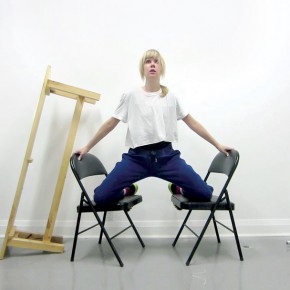
Image: Michael Pittman, “Hob”, acrylic, india ink and graphite on cradled birch paper, 81 x 121 cm. on view at St. John’s Bonnie Leyton Gallery, May 2 – 30, 2015.
As we walked downtown, my friend described how two old hags had chewed on either side of her neck the night before. It wasn’t the first time. “I’ve learned that the trick,” she told me, “is that I just have to let it happen, to remind myself that it’s not real.” This was a hag dream, a form of sleep paralysis where one wakes to discover not only the inability to move, but the presence of a dark figure and a saturating feeling of dread. On the island of Newfoundland, hag dreams are as common and acceptable a topic as the weather. This is a place where one is often told to carry a biscuit to appease the faeries. Here, there is a word for meeting a figure in the fog—a “fetch”—which may show itself as a ship, a stranger on their deathbed or even oneself. The Dictionary of Newfoundland English describes such as an encounter as “annoyingly familiar at sea.”
Michael Pittman’s new body of drawings and paintings reveal memories as a form of specter. A memory can be a lonely, haunting thing. It is a singularly personal experience that can’t be relayed adequately to others and, over time, can become increasingly tentative to the one who experienced it originally.
“This body of work started with drawing a big red trike stuck in the thin, creaking ice of a newly caught pond,” Pittman says. “It was a memory from my childhood combined with an early lucid dream that seems as real today as it did when I was four—having become virtually indistinguishable from reality with the passing of years.”
With these works (on view in the exhibition Stories at St. John’s Bonnie Leyton Gallery, May 2-30, 2015) Pittman’s narrative is contained in the layers of making and undoing. His aesthetic echoes the uncertainty found in the familiar, and explores these ‘hauntings’ as the shifting lexicon for approaching new encounters. His paintings are a palimpsest of erasures and washes that navigate multiple half-seen associations. My Brother’s Mask (2015), for example, describes the distance felt with those one knows well. Around the figures float hints of mundane objects and events from various times, clues for a story the viewer will never fully grasp.
Pittman lives in Grand Falls-Windsor, where his family is based. He learned from his mother that knitting, once made, can be unraveled. From his father he learned that bedtime stories can be made up as one goes along. The birth of a son has done very little to slow down an exceptionally prolific practice that includes paint, film and sculpture. Becoming a father has caused Pittman to focus on the stories of his childhood, searching for the language to relay them to his son. Fatherhood has also meant less time to indulge, less time to frustrate a work with corrective gestures. By Pittman’s own admission, his previous works could occasionally be pushed a step too far: “[There’s an] obsessiveness to part of my process that I do not fully understand and can’t rightly explain, except to say that [it is] necessary.” He moved to ink drawings as he cared for his newborn. In addition to allowing him multiple objects to work on at once, this medium let him step back from the keenly malleable yet precious quality of paint. Able to be tight and intensive on paper, his painted work has become more intuitive. He has discovered the benefit of letting go.
This new body of work shows that the substance of a story exists not only in the forgetting, but in the flotsam that floats to the surface in the remembering. In the drawing Breach (2015), a large whale is densely wrapped in fabric, resting directly underneath the outline of a ship. To ‘breach’ means to come to the surface: “It creates a gap through which things could be either accessed or lost,” Pittman tells me. Here, a whale is usually an enormous yet ethereal figure seen from above, made foreign by the thin meniscus of water that separates it from the viewer. In this work, it is the observer that is tentative. The tangible is found below the surface.















I flew to St. John’s in May largely to take in Michael Pittman’s new show. It was fabulous — mesmerizing. The piece I bought (Hoarfrost) now hangs in my entrance hallway, viewable every morning as I descend the stairs to the first floor of the house. I am astonished by its haunting beauty every time I take it in.